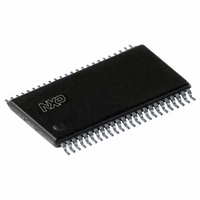SC28L201A1DGG,112 NXP Semiconductors, SC28L201A1DGG,112 Datasheet - Page 34

SC28L201A1DGG,112
Manufacturer Part Number
SC28L201A1DGG,112
Description
IC UART W/FIFO 48-TSSOP
Manufacturer
NXP Semiconductors
Series
IMPACTr
Datasheet
1.SC28L201A1DGG118.pdf
(110 pages)
Specifications of SC28L201A1DGG,112
Features
False-start Bit Detection
Number Of Channels
2, DUART
Fifo's
256 Byte
Voltage - Supply
3.3V, 5V
With Parallel Port
Yes
With Auto Flow Control
Yes
With False Start Bit Detection
Yes
With Modem Control
Yes
With Cmos
Yes
Mounting Type
Surface Mount
Package / Case
48-TSSOP
Lead Free Status / RoHS Status
Lead free / RoHS Compliant
Other names
568-3293-5
935277824112
SC28L201A1DGG
935277824112
SC28L201A1DGG
Philips Semiconductors
9397 750 13138
Product data sheet
7.4.10.2 Xon/Xoff characters
7.4.10.3 Host mode (least efficient)
7.4.10.4 Auto-transmitter mode
11 — Auto Rx and Tx control. Receiver commands Tx to send Xoff as the receiver fills
and commands the Tx to send Xon when Rx FIFO fill level is lowered. This results in total
automatic control. No processor interrupt is required.
Note that MR3[7] controls the stripping of Xoff/Xon characters.
0 — Xon/Xoff characters are sent to the Rx FIFO
1 — Xon/Xoff characters are discarded
The MR3[7] functions regardless of the setting of MR3[3:2]. This allows for general
purpose character recognition and processing (see
The programming of these characters is usually done individually. The standard Xon/Xoff
characters are: Xon is 0x11, Xoff 0x13. Any enabling of the Xon/Xoff functions will use the
contents of the Xon and Xoff character registers as the basis on which recognition is
predicated.
When neither the auto-receiver or auto-transmitter modes are set, the Xon/Xoff logic is
operating in the host mode. In host mode, all activity of the Xon/Xoff logic is initiated by
commands to the CRx. The Xoff command forces the transmitter to disable exactly as
though an Xoff character had been received by the RxFIFO. The transmitter will remain
disabled until the chip is reset or the CR[7:3] = 1 0110 (Xoff resume) command is given. In
particular, reception of an Xon or disabling or re-enabling the transmitter will not cause
resumption of transmission. Redundant CRTXxx commands, that is ‘CRTXon, CRTXon’,
are harmless, although they waste time. A CRTXon may be used to cancel a CRTXoff
(and vice versa) but both may be transmitted depending on the command timing with
respect to that of the transmitter state machine.
When a channel receiver loads an Xoff character into the RxFIFO, the channel transmitter
will finish transmission of the current character and then stop transmitting. A transmitter so
idled can be restarted by the receipt of an Xon character by the receiver or by a hardware
or software reset. The last option results in the loss of the un-transmitted contents of the
TxFIFO. When in this mode and waiting for an Xon signal from the receiver, the CR
(Command Register) commands for the transmitter are not effective.
While idle in this mode and waiting for an Xon signal from the receiver, data may be
written to the TxFIFO and it continue to present its fill level to the interrupt arbiter and
maintains the integrity of its status registers.
Use of ‘00’ as an Xon/Xoff character is complicated by the Receiver break operation which
loads a ‘00’ character on the RxFIFO. The Xon/Xoff character detectors do not
discriminate in this case from an Xon/Xoff character received through the RXD pin.
Remark: To be recognized as an Xon or Xoff character, the receiver must have room in
the RxFIFO to accommodate the character. An Xon/Xoff character that is received
resulting in a receiver overrun does not effect the transmitter nor is it loaded into the
RxFIFO, regardless of the state of the Xon/Xoff transparency bit, MR3[7].
Rev. 01 — 31 October 2005
3.3 V, 5 V UART, 3.125 Mbit/s, with 256-byte FIFO
Section 7.4.9.1 “Character
© Koninklijke Philips Electronics N.V. 2005. All rights reserved.
SC28L201
stripping”).
34 of 110















